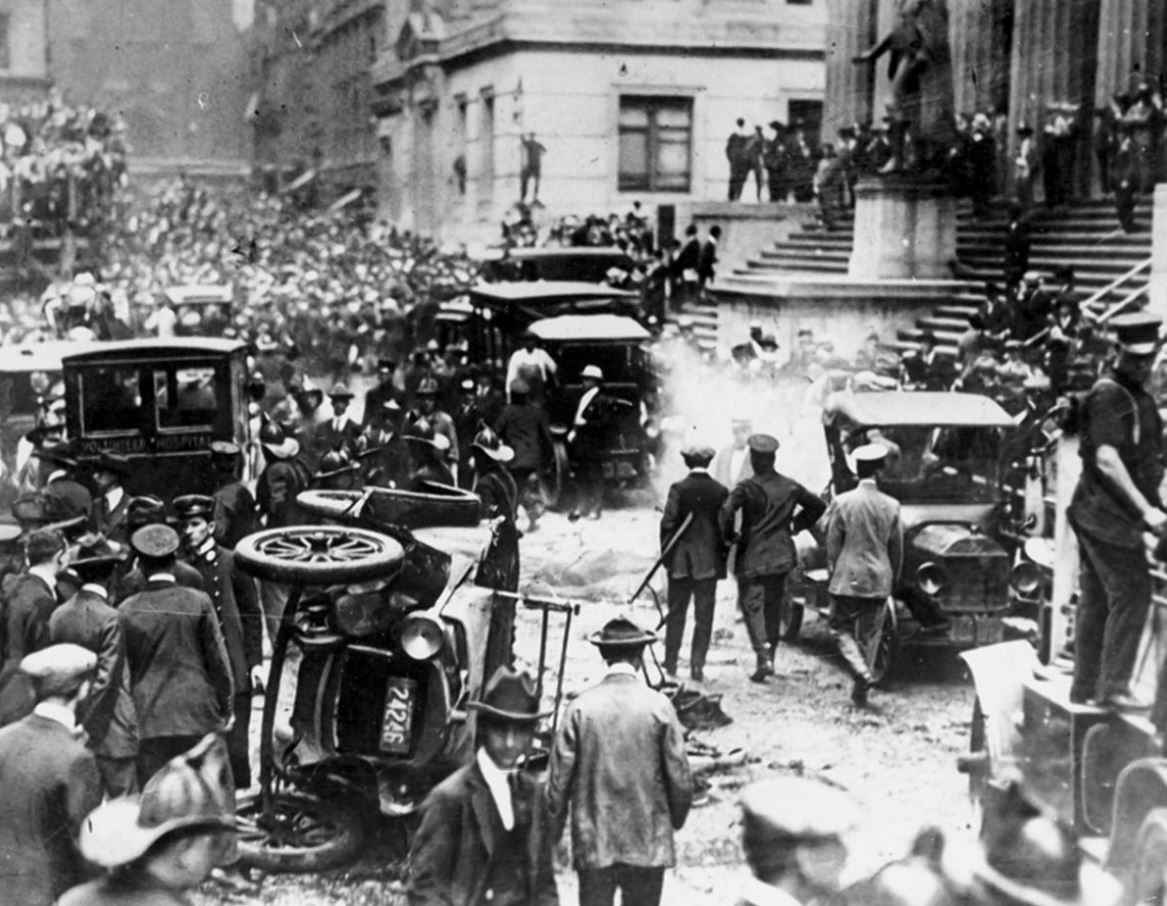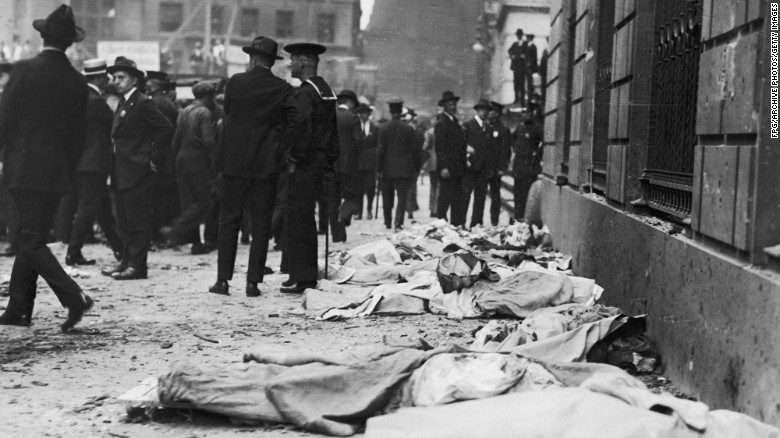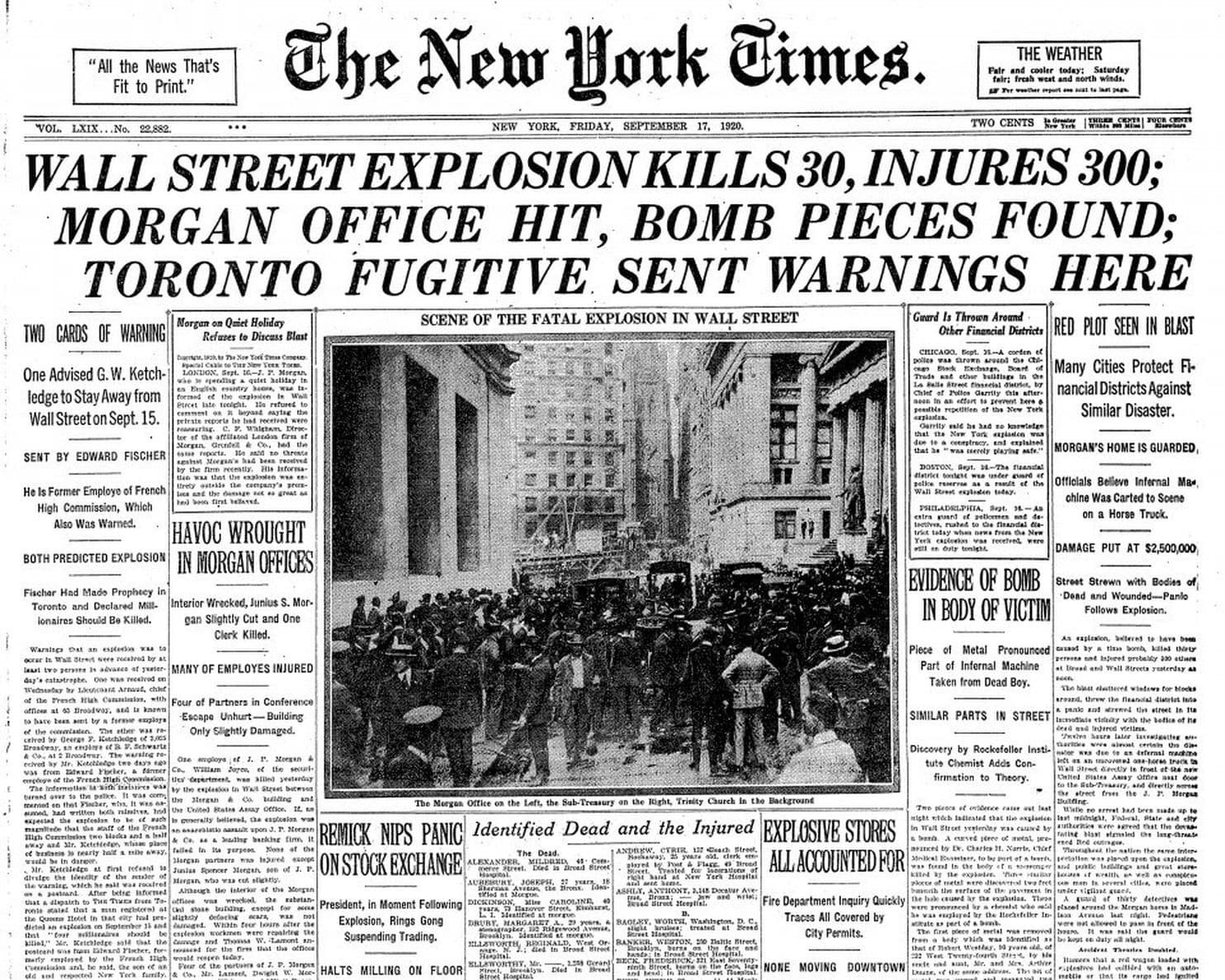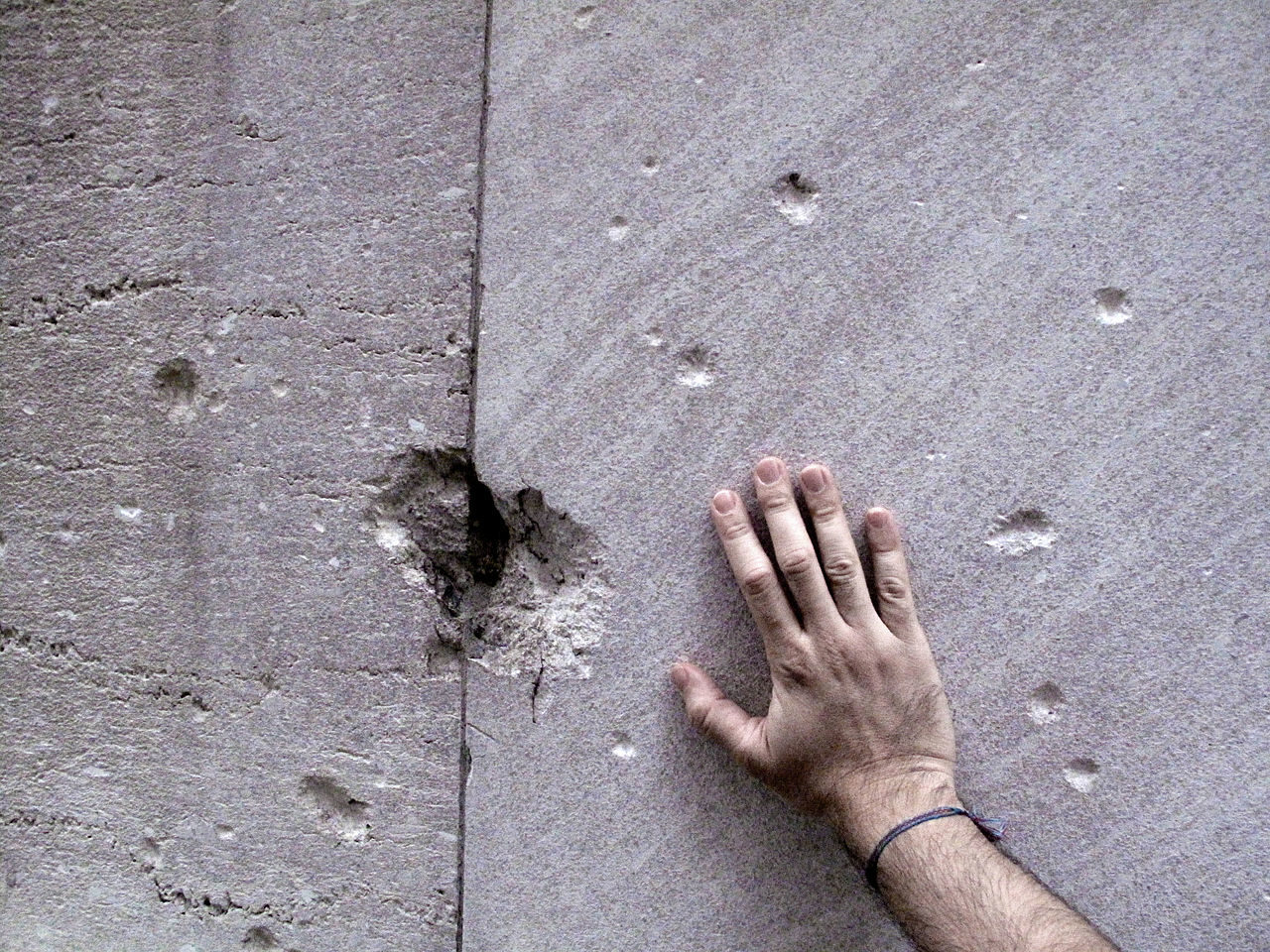Rain was in the forecast for September 16, 1920, but as the bells of nearby Trinity Church rang in the noonday hour, "the Corner" was its usual hive of activity. Bank clerks and stockbrokers swarmed around the building fronts, and the streets were clogged with automobiles and messenger boys. Few in the lunchtime crowd paid any notice to the battered horse-drawn wagon parked in front of the Assay Office, nor the driver that had anxiously dropped the reigns and hurried off down the street.
The final ring of the church bells was still hanging in the air at 12:01, when the 100 pounds of dynamite concealed in the wagon detonated with an ear-splitting roar. "That was the loudest noise I ever heard in my life," J.P. Morgan employee Andrew Dunn later remembered. "It was enough to knock you out by itself." The blast derailed a streetcar a block over and sent debris soaring as high as the 34th floor of the nearby Equitable building. Pieces of the wagon's ill-fated horse landed hundreds of yards away. Stockbroker Joseph P. Kennedy, father of future President John F. Kennedy, was lifted clear off his feet by the concussion, as were many others.
Those closer to the wagon were consumed in pillars of flame or cut to pieces by the hundreds of pounds of metal fragments - most likely iron sash weights - that had been cruelly piled on top of the bomb to act as shrapnel. "I saw the explosion, a column of smoke shoot up into the air and then saw people dropping all around me, some of them with their clothing afire," a witness later told the New York Sun. Next came a rain of glass from shattered windows, which drenched the streets and nearby offices. The inside of the Morgan building was raked by debris. One piece crushed the skull of 24-year-old clerk William Joyce as he sat at his desk.
To the many World War I veterans on hand, the devastation at ground zero was eerily reminiscent of a battlefield. Wall Street was rendered a no man's land of spattered blood, broken glass and charred bodies. The air was thick with smoke and soot, and severed limbs littered the ground. "Almost in front of the steps leading up to the Morgan bank was the mutilated body of a man," wrote reporter George Weston, who had escaped injury by ducking into a doorway. "Other bodies, most of them silent in death, lay nearby. As I gazed horror stricken at the site, one of these forms, half-naked and seared with burns, started to rise. It struggled, then toppled and fell lifeless into the gutter."
Trading at the Stock Exchange ground to a halt, and some 2,000 New York City policemen and Red Cross nurses converged on Wall Street to comb through the wreckage. The initial explosion had killed 30 men and women, and another eight would later die from their wounds. Hundreds more were injured, many of them burned or maimed by flying glass and shrapnel.
The attack would remain the deadliest terrorist incident on U.S. soil until the Oklahoma City bombing 75 years later, yet investigators initially struggled to explain who had carried it out or why. The obvious target was the Morgan bank, which some critics claimed had profited off the horrors of World War I, but most of the wagon bomb's victims were lowly stenographers and clerks - not wealthy businessmen. J.P. Morgan, Jr. himself had been thousands of miles away in Europe when the dynamite went off. "There was no objective except general terrorism," wrote the St. Louis Post-Dispatch. "The bomb was not directed against any particular person or property. It was directed against a public, anyone who happened to be near or any property in the neighborhood."
Comment: Or both: the building as a symbol was targeted, in order to direct the public mind.
With the first Red Scare still in full swing, most of the finger pointing soon centered on anti-capitalist communist and anarchist groups, which had been blamed for dozens of other bombings dating back to the 19th century. Suspicions only grew on September 17, when postal workers found a stack of flyers that had been dropped in Financial District mailboxes just minutes before the blast. "Remember," they read, "we will not tolerate any longer. Free the political prisoners, or it will be sure death for all of you. American Anarchist Fighters." The letters bore a striking resemblance to those circulated after an earlier terror campaign from June 1919, when bombs went off in several U.S. cities.
Comment: Immaculate passports and ID cards found at the scene of the crime, anyone?
Police had since credited that plot to the Galleanists, a gang of anti-government Italian anarchists led by a rousing orator and explosives guru named Luigi Galleani. Galleani had been deported the previous year, but many aspects of the Wall Street bomb - particularly the use of iron weights as shrapnel - matched the "infernal machines" that he and his followers had crafted in the past.
Comment: Anarchists, terrorists... maybe by the 22nd century the false opposition will be called chaosists?
Unfortunately for the authorities, the mysterious fliers were the closest anyone ever came to claiming responsibility for the attack. Police and agents from the Bureau of Investigation (later the FBI) spent over three years trying to crack the case and identify the wagon's driver, but the Galleanist trail went cold, as did dozens of others involving everyone from trade unionists to the American communist party and even Vladimir Lenin himself. One of the stranger dead ends concerned Edward Fischer, a mentally unstable tennis champion who had warned people to stay away from Wall Street in the days preceding the attack. Once investigators learned that Fischer had issued several previous Wall Street warnings - each one of them supposedly received "through God and the air" - they dropped him as a suspect and committed him to a psychiatric ward.
The last official inquiry into the Wall Street attack took place in 1944, when the FBI reopened the decades-old cold case and concluded the explosion was likely the work of "Italian anarchists or Italian terrorists." Other investigators have since pointed to a Galleanist named Mario Buda as the most likely culprit. Buda was an associate of the famed anarchists Nicola Sacco and Bartolomeo Vanzetti, and he may have engineered the Wall Street attack as revenge for their September 11, 1920 indictment for murder in a robbery gone wrong. Buda fled to Italy shortly after the bombing, however, and remained there until his death. Neither he nor anyone else was ever charged with the September 16 attack.
Wall Street reopened only a day after the deadly explosion, "determined," wrote the New York Sun, "to show the world that business will proceed as usual despite bombs." Bandaged office clerks returned to their desks, and all signs of the blast were covered up or swept away-including many pieces of evidence that might have helped in the police investigation. That afternoon, thousands of New Yorkers descended on the scene of the disaster and joined in renditions of "America the Beautiful" and the national anthem.
Looming behind them was the Morgan building, its marble edifice marred by fist-deep holes from bomb shrapnel. The scars are still visible on the building today - the lone monument to an unsolved crime that claimed 38 lives.







Comment: Fast-forward a century. We're all older and wiser. We're now so familiar with the concept of false-flag terror attacks that they're portrayed in movies.
With the benefit of hindsight, it's quite clear that the Rothschild-JP Morgan building was targeted to generate sympathy for the world's most powerful financial syndicate, thus blocking/stymieing/silencing increasing popular dissent at that syndicate's inordinate influence over the US government.
The reason this kind of 'self-inflicted wound' type of attack keeps happening is because it's so bloody obvious to a psychopathic mind that it's the logical thing to do 'when the host population get restless'...